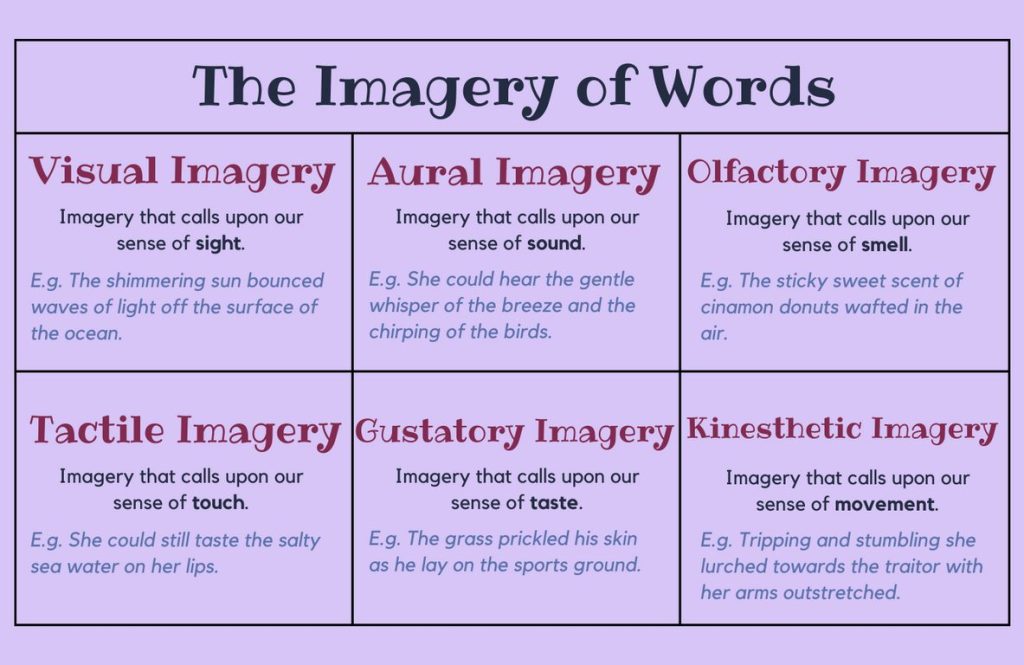Understanding Imagery: Definition, Types, and Examples
Table of Contents
Introduction
Imagery
In the realm of literature and communication, the concept of imagery holds significant importance. Let’s delve into the world of imagery, exploring its definition, various types, and compelling examples to gain a comprehensive understanding of its role in creating impactful and evocative content.
Analogy of Definition
What is Imagery?
Imagery refers to the use of descriptive language and sensory details to create mental images, stimulating the reader’s senses and emotions. It paints a vivid picture in the reader’s mind, making the writing more vibrant and immersive.
Method
Types of Imagery
There are several types of imagery, each appealing to different senses to evoke a rich sensory experience. Visual imagery pertains to sight, auditory imagery to sound, olfactory imagery to smell, gustatory imagery to taste, and tactile imagery to touch.
Visual Imagery: Visual imagery refers to descriptive language that creates vivid mental images by appealing to the sense of sight. It paints a picture in the reader’s mind using detailed descriptions of colors, shapes, and visual elements.
Example: “The sun dipped below the horizon, casting a warm golden glow across the tranquil sea.”
Auditory Imagery: Auditory imagery evokes sounds and auditory sensations through descriptive language. It allows the reader to hear the sounds described in the text, immersing them in the auditory experience.
Example: “The birds chirped melodiously in the treetops, filling the air with their cheerful song.”
Olfactory Imagery: Olfactory imagery appeals to the sense of smell by describing scents and aromas. It transports the reader to different environments by evoking specific smells and fragrances.
Example: “The aroma of freshly baked bread wafted through the air, tempting passersby with its warm, comforting scent.”
Gustatory Imagery: Gustatory imagery describes tastes and flavors, stimulating the reader’s sense of taste. It uses descriptive language to evoke the sensation of different tastes and culinary experiences.
Example: “The tangy sweetness of ripe strawberries exploded on her tongue, leaving behind a refreshing sensation.”
Tactile Imagery: Tactile imagery appeals to the sense of touch by describing textures, sensations, and tactile experiences. It allows the reader to feel the physical sensations described in the text.
Example: “The rough bark of the old oak tree scraped against her fingertips as she reached out to trace its gnarled surface.”

Imagery in Literature
One notable example of imagery can be found in William Shakespeare’s play “Romeo and Juliet.” In Act 2, Scene 2, Romeo describes Juliet’s beauty using rich sensory imagery, painting a vivid picture of her in the reader’s mind:
“But, soft! What light through yonder window breaks?
It is the east, and Juliet is the sun.
Arise, fair sun, and kill the envious moon,
Who is already sick and pale with grief,
That thou her maid art far more fair than she.”
In this passage, Shakespeare employs visual imagery to describe Juliet as radiant and luminous, comparing her to the sun and contrasting her beauty with the pale moon. This imagery not only captures Romeo’s admiration for Juliet but also emphasizes her ethereal beauty and presence. By appealing to the reader’s sense of sight, Shakespeare creates a vivid and memorable image of Juliet that enhances the emotional impact of the scene.
Overall, imagery is a figure of speech that enriches writing by engaging the reader’s senses and creating immersive experiences. It allows writers to convey complex emotions, vivid settings, and dynamic characters, making it an essential tool for storytelling
Imagery is widely used in literature, including poems. It enhances the reader’s ability to imagine and visualize. In Robert Frost’s “The Road Not Taken,” the visual imagery of two roads diverging in a yellow wood symbolizes life’s choices and decisions. Overall, imagery in literature enhances storytelling by immersing readers in sensory experiences that deepen their understanding of characters, settings, and themes.
Literal and Figurative Imagery
Literal imagery refers to descriptions that depict concrete, tangible objects and sensory experiences in a straightforward manner. For example, a passage describing the colors of a sunset, the sound of waves crashing on the shore, or the smell of freshly baked bread would be considered literal imagery.
Figurative imagery, on the other hand, involves the use of figurative language such as similes, metaphors, and personification to create imaginative and symbolic representations. Figurative imagery often employs comparisons or associations between unrelated things to convey deeper meanings and emotions. For instance, describing a character’s smile as “bright as the sun” or a stormy sky as “angry clouds” involves figurative imagery, as these descriptions go beyond the literal meanings of the words to evoke specific impressions and feelings.
Both literal and figurative imagery play essential roles in literature, allowing writers to engage readers’ senses and emotions, enriching their understanding and appreciation of the text. By skillfully employing imagery, writers can create immersive and evocative worlds that resonate with readers long after they’ve finished reading.
Examples
Example 1: Visual Imagery
The sun dipped below the horizon, painting the sky with hues of crimson and gold, casting long shadows across the tranquil lake.
Example 2: Auditory Imagery
The symphony of chirping birds and rustling leaves filled the air, creating a melodic backdrop to the serene forest.
Example 3: Olfactory Imagery
The aroma of freshly baked bread wafted through the kitchen, enveloping the room in a warm, comforting embrace.
The examples above vividly illustrate the use of imagery to create sensory experiences for the reader. Through visual, auditory, and olfactory imagery, the writing becomes more immersive and evocative, allowing the reader to connect deeply with the content.
Quiz
Tips and Tricks
1. Engaging Visual Imagery
Tip: Use descriptive language to paint vivid visual images in the reader’s mind, appealing to their sense of sight.
2. Evocative Auditory Imagery
Tip: Incorporate sounds and onomatopoeic words to create auditory imagery, engaging the reader’s sense of hearing.
3. Captivating Olfactory Imagery
Tip: Describe scents and aromas in detail to evoke olfactory imagery, appealing to the reader’s sense of smell.
Real life application
Scenario 1: Advertising
Story: A perfume advertisement utilizes vivid visual and olfactory imagery to evoke a sense of luxury and allure, captivating the audience’s senses and emotions.
Scenario 2: Public Speaking
Story: A motivational speaker incorporates powerful auditory imagery to create an emotional connection with the audience, making the message more impactful and memorable.
FAQ's
Like? Share it with your friends






